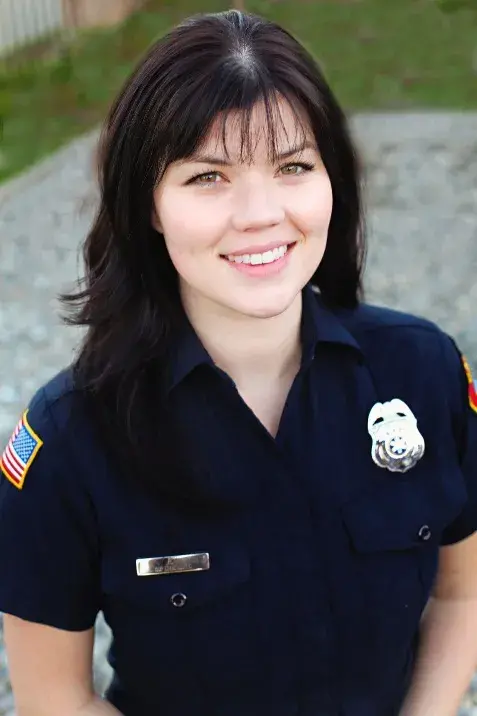The Department of Homeland Security (DHS) Science and Technology Directorate’s (S&T) First Responders Group (FRG) relies on experienced emergency response and preparedness professionals to guide its research and development efforts. The First Responder Resource Group (FRRG) fills that role. An all-volunteer working group, the FRRG helps S&T maintain focus on the top-priority needs of responders in the field. This new series will highlight several FRRG members, offering a glimpse into their daily responsibilities, as well as their ongoing support of S&T technology development.
 Meet Anne M. Jensen, a paramedic and Resource Access Program (RAP) Coordinator for the San Diego Fire-Rescue Department’s Emergency Medical Services (EMS). In this capacity, she links frequent EMS users with additional health, mental health and social needs resources in order to reduce dependency on the city’s services.
Meet Anne M. Jensen, a paramedic and Resource Access Program (RAP) Coordinator for the San Diego Fire-Rescue Department’s Emergency Medical Services (EMS). In this capacity, she links frequent EMS users with additional health, mental health and social needs resources in order to reduce dependency on the city’s services.
“I work with four other community paramedics. In a typical day, we answer calls for help from other paramedics and firefighters who feel that they can’t help a patient in the right way,” Jensen said. “There are usually social issues, psychiatric issues, difficult chronic medical issues, homelessness…we also respond to alerts from an electronic surveillance system that finds people who may be especially vulnerable community members. We visit these patients and try to help them get the resources they need. Since many of these individuals are difficult, or may need court-mandated treatment, we often work with law enforcement officers and other city and county agencies,” she continued.
With a background in paramedicine and applied physics, Jensen shared that choosing a career as an emergency medical technician (EMT) was not her initial plan. “I don’t know that I did decide on being an EMT. Or rather, it was just a whim,” she said. “I watched an ambulance transfer an accident victim into a helicopter that had landed on the front lawn of a private property in my hometown. I was filling out college applications at the time, and only one of the schools offered courses in paramedicine — that was the only school I ended up applying for because I was so interested in the concept of emergency response. My brain didn't have room to accept any other option.”
“Later on, as I had more paramedic experiences, I felt like I needed a better explanation of the universe, to reconcile what I had seen on the job. That’s when I decided to also study physics. As odd as it may sound, it’s a helpful degree to supplement the work of a paramedic,” expressed Jensen.
We asked Jensen about a typical day and key takeaways from her job “I’ve had the opportunity to build the [RAPS] program alongside some very talented people. I would never have imagined that I would be involved in such a meaningful, complicated, rewarding, non-traditional project. I think the key to this job or a different profession is to engage yourself in good causes, be disciplined, and give it your all. If you do that, it will be meaningful to you and those around you.”
Jensen is no stranger to working with DHS S&T and has long been a go-to for feedback and technology field testing. Initially, she was a member of FRG’s former First Responder Working Group. When that group was dissolved, she contributed as a subject matter expert and then transitioned into what is now the FRRG. We first profiled her work during a 2013 Women’s History Month feature, and she contributed a FirstResponder.gov article about her overall impressions of FRG’s Wireless Patient Vital Signs Monitoring Device. She can also be seen offering her thoughts on the benefits of being an FRRG member in the newest installment of FRG’s FINDER The Bigger Story video, recorded at the 2014 FRRG Meeting in Washington, D.C.
Jensen said the meeting was organized, methodical and productive and would definitely recommend her colleagues participate in the future. “I felt that DHS was really interested in understanding our needs. I particularly enjoyed seeing all of the demonstrations. It’s rewarding to see that our past hard work has resulted in tangible devices! I can’t wait to see them being used in the field.”
She enjoys working with the FRRG and said she would recommend it to colleagues. “I would definitely recommend it. I love EMS, but it is complicated. We deal with inconsistencies in governance, structure, funding and medical billing. The FRRG is a way to step out of the box, and brainstorm and collaborate with other first responders.”
Check back soon for additional FRRG member spotlights. For more information on how to become a member of the FRRG, contact first.responder@hq.dhs.gov.
